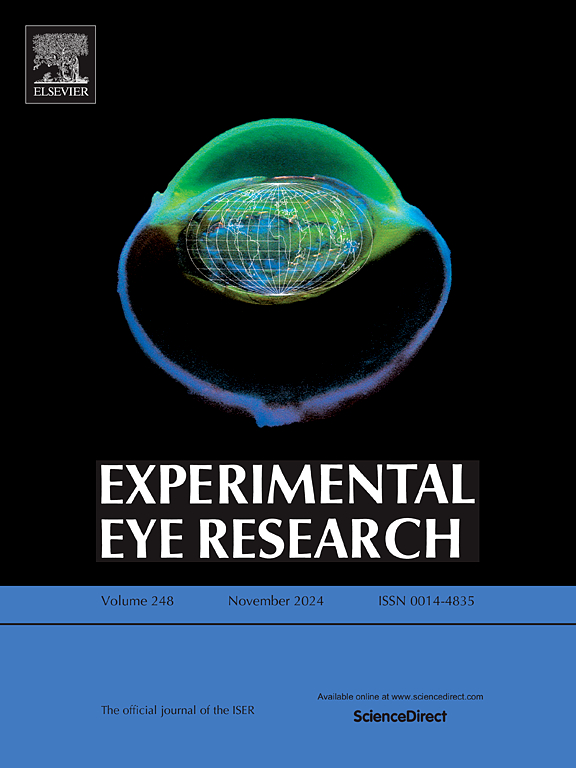跨组织转录组关联研究揭示过敏性结膜炎易感基因
IF 3
2区 医学
Q1 OPHTHALMOLOGY
引用次数: 0
摘要
过敏性结膜炎(Allergic conjunctitis, AC)是一种常见的免疫介导的眼部疾病,临床表现为眼痒、结膜充血、流泪、黏液排出等,严重影响患者的视觉功能和生活质量。尽管广泛的研究致力于揭示AC的遗传易感性,但潜在的致病基因和分子机制仍然不完全清楚,需要进一步的研究来阐明其遗传基础。本研究利用FinnGen R12的AC数据,并结合基因型-组织表达v8数据库中的表达数量性状位点数据,进行了跨组织转录组关联研究(TWAS)。分析方法包括基于功能摘要的归算(FUSION)、分子特征统一检测(most)和结合多标记基因组注释的基因分析(MAGMA)。为了进一步验证结果,进行了孟德尔随机化(MR)分析和共定位分析。通过TWAS和MAGMA分析,鉴定出13个与AC相关的易感基因。通过MR和共定位分析,最终选择了三个候选基因——gal3st2、PDCD1和tlr6,并通过FUMA工具进行了验证,它们可能通过调节toll样受体信号通路影响AC的进展。总之,我们确定了三个与AC风险相关的易感基因,为AC的遗传机制和潜在的致病途径提供了新的见解。本文章由计算机程序翻译,如有差异,请以英文原文为准。
Susceptibility genes for allergic conjunctivitis revealed by cross-tissue transcriptome-wide association study
Allergic conjunctivitis (AC) is a common immune-mediated ocular disorder, characterized by clinical manifestations such as ocular itching, conjunctival hyperemia, lacrimation, and mucoid discharge, which significantly impair patients' visual function and quality of life. Despite extensive research efforts devoted to uncovering the genetic predisposition to AC, the underlying pathogenic genes and molecular mechanisms remain incompletely understood, necessitating further research to elucidate its genetic basis. This study utilized AC data from the FinnGen R12 and incorporated expression quantitative trait loci data in the Genotype-Tissue Expression v8 database to perform a cross-tissue transcriptome-wide association study (TWAS). Analytical methods included functional summary-based imputation (FUSION), unified test for molecular signatures (UTMOST), and gene analysis combined with multi-marker genome annotation (MAGMA). To further validate the results, Mendelian randomization (MR) analysis and colocalization analysis were performed. Through TWAS and MAGMA analyses, 13 susceptibility genes associated with AC were identified. Following MR and colocalization analyses, three candidate genes—GAL3ST2, PDCD1 and TLR6—were ultimately selected and validated by FUMA tool, which may influence progression of AC by regulating pathways related to Toll-like receptor signaling. In conclusion, three susceptibility genes linked to the risk of AC were identified, providing new insights into the genetic mechanisms and potential pathogenic pathways underlying AC.
求助全文
通过发布文献求助,成功后即可免费获取论文全文。
去求助
来源期刊

Experimental eye research
医学-眼科学
CiteScore
6.80
自引率
5.90%
发文量
323
审稿时长
66 days
期刊介绍:
The primary goal of Experimental Eye Research is to publish original research papers on all aspects of experimental biology of the eye and ocular tissues that seek to define the mechanisms of normal function and/or disease. Studies of ocular tissues that encompass the disciplines of cell biology, developmental biology, genetics, molecular biology, physiology, biochemistry, biophysics, immunology or microbiology are most welcomed. Manuscripts that are purely clinical or in a surgical area of ophthalmology are not appropriate for submission to Experimental Eye Research and if received will be returned without review.
 求助内容:
求助内容: 应助结果提醒方式:
应助结果提醒方式:


